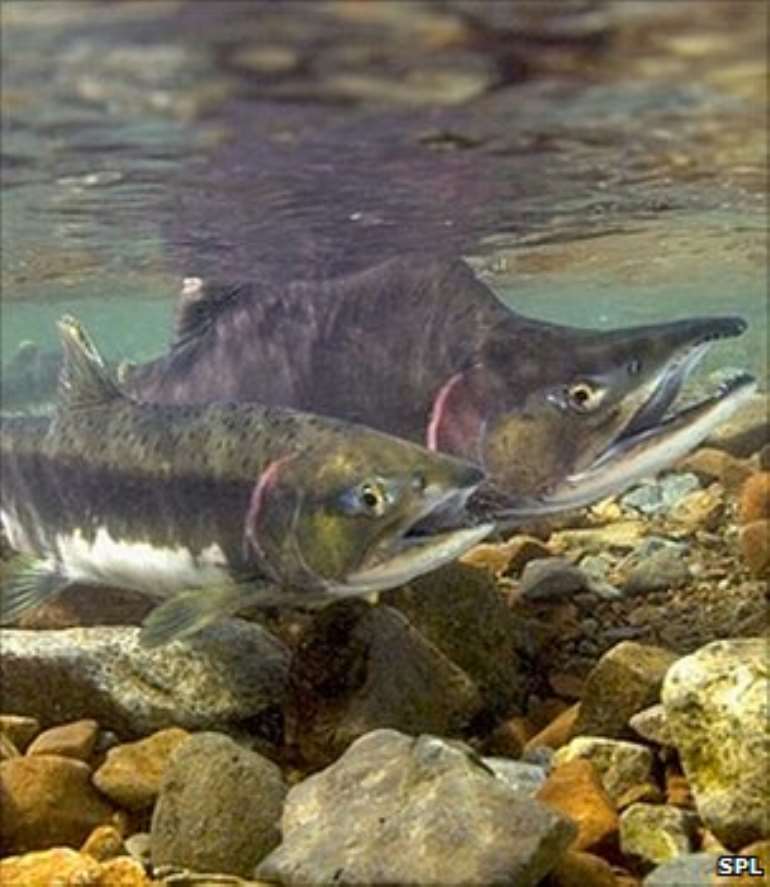SEA LICE ‘NOT TO BLAME FOR PACIFIC SALMON DECLINE’

They usually move about 64km (40 miles) upstream but may move as much as 480km in larger rivers
(Source: Fisheries and Oceans Canada)
Sea lice carried by farmed salmon are not responsible for a sharp decline in the wild population of a species of Pacific salmon, a report suggests.
There were concerns that sea lice from fish farms would cause the region's wild pink salmon to become extinct.
However, a study by scientists suggests that separating farm fish from wild fish would not increase the survival chances of wild pink salmon.
The findings appear in the Proceedings of the National Academy of Sciences.
“Increased farm salmon production has heightened concerns about the association between disease on farm and wild fish,” the team of researchers from North America wrote.
“The controversy is particularly evident in the Broughton Archipelago of Western Canada, where a high prevalence of sea lice was first reported on juvenile pink salmon in 2001.”
They added that this led to a theory that exposure to lice from farmed Atlantic salmon (Salmo salar) was likely to be responsible for a 97% decline in wild pink salmon (Oncorhyncus gorbuscha) returning to spawn in 2002.
“One concern about salmon farms is that they are the source of ectoparasitic sea lice infestations that might reduce the marine survival of wild salmon,” they explained.
Atlantic salmon farming in the region began in the early 1980s, and the number of establishments grew steadily for the next two decades.
When juvenile pink salmon were examined in 2001, scientists found that 90% of the young fish were infested.
While adult fish are natural hosts for a species of sea louse (Lepeophtheitus salmonis), it is was considered rare for young pink salmon to carry the parasites, the researchers said.
They added that previous studies had attempted to see whether the lice were causing a decline in the wild salmon population but were not able to reach definitive conclusions.
Looking for answers
The team analysed newly available information that consisted of up to 20 years of fish farm data and 60 years worth of records for pink salmon in order to assess the “interrelationship between wild pink salmon, sea lice and farmed Atlantic salmon” in the area.
The researchers found that the total number of recorded lice was not linked to the overall number of farmed fish. While the data suggested that there was a large degree of variation in the level of lice infestation on farmed salmon, the number of fish in the farms were relatively stable.
“Farm salmon enter the marine environment free of sea lice, but sea lice in the environment start to infest the fish within a few months of stocking,” they observed.
The data also showed that Lepeophtheitus salmonis numbers were relatively low in late summer before steadily increasing during the autumn, when adult salmon (infested with lice) returned to the area to spawn, and winter (when increased salinity favoured louse reproduction).
“The magnitude of the annual cycle is associated with adult pink salmon returns,” the researchers from Canada and the US wrote.
However, they added that co-ordinated treatment by managers of the fish farms had “truncated the relationship” between the wild salmon returns and infestation of farms in recent years.
In an attempt to shed light on why juvenile wild salmon were becoming infested with lice, the team said tests were carried out to see whether the lice were killing the fish, or whether the lice were merely taking the opportunity of sick fish that had been subject to another environmental factor that had damaged their health.
“Based on extrapolations from controlled laboratory studies, infestation levels… might have killed 8% if the juvenile salmon [leaving the area].”
In other words this was not enough to destabilise the wild population, they added: “Death caused by sea lice exposure replaced death caused by other causes, resulting in no net change in generational survival.”
Another clue that suggested that lice infestations were not responsible for an increase in mortality of the species was recorded in 2001, they reported.
“Sick juvenile pink salmon frequently had 'bleeding at the base of the fins', but this lesion does not occur in pink salmon exposed to Pacific-source L. salmonis under controlled laboratory conditions.
“Instead, the reddening of the fins is commonly associated with stressful environmental conditions or bacterial and viral infections.”
The team recommended adding medical analysis to current investigations in order to help government organisations develop “cost-effective regulations to sustain healthy wild salmon populations”.
